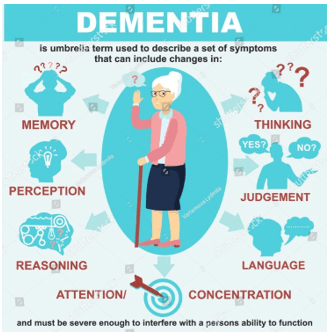A nurse is caring for a client who has dementia.
Which of the following findings should the nurse expect?
Memory loss that disrupts ADLs
Catatonia
Illusions
Pressured speech
The Correct Answer is A
a. Memory loss that disrupts ADLs
Explanation: Dementia is a condition characterized by a decline in cognitive function that affects a person's ability to perform activities of daily living (ADLs). Memory loss is a common symptom of dementia, particularly in the early stages. The memory loss can disrupt a person's ability to carry out tasks they were previously able to do independently, such as dressing, bathing, and eating. Therefore, option a is the correct answer.
Option b, catatonia, is a condition characterized by a lack of movement or activity, which is not typically associated with dementia.
Option c, illusions, involve a misinterpretation of sensory information and may occur in some forms of dementia but are not a defining feature.
Option d, pressured speech, is a symptom commonly associated with mania or bipolar disorder, but is not typically seen in dementia.

Nursing Test Bank
Naxlex Comprehensive Predictor Exams
Related Questions
Correct Answer is D
Explanation
A.Low-level lighting can increase confusion and the risk of falls, especially for clients with memory loss. It is important to have adequate lighting to promote a safe environment and help with orientation. Well-lit areas can reduce disorientation and anxiety in clients who are confused or have memory issues.
B.Offering several meal options might overwhelm and further confuse the client. For clients with memory loss and confusion, it is better to provide simple choices or pre-selected meals to reduce decision-making stress and confusion. Too many choices can lead to frustration.
C.Confronting a client with memory loss or confusion about inappropriate behavior can increase agitation, anxiety, and defensive reactions. Instead, redirecting the client or using calm, reassuring approaches would be more effective in managing behavior and preventing escalation.
D.Symbols and pictures can help clients with memory loss navigate their environment more easily because they may have difficulty reading or comprehending written language. Visual cues such as symbols in signage can improve orientation and independence, helping the client feel more comfortable in their surroundings.
Correct Answer is B
Explanation
Choice A Reason:
Recording blood glucose levels during a 24-hour creatinine clearance test is not typically necessary for this test. This test primarily measures kidney function, not blood glucose levels.
Choice B Reason:
"You can begin collection of urine after discarding your first morning void." When conducting a 24-hour creatinine clearance test, the client should begin the collection of urine after discarding their first morning void. This helps ensure that the urine collected during the test is a continuous sample that includes both daytime and nighttime urine output. The client should discard the first void of the day but then collect all urine voided for the next 24 hours, including the first void of the following morning.
Choice C Reason:
Eating a protein-rich diet during the collection period can affect the accuracy of the test results, as it may increase creatinine excretion. The client should follow the healthcare provider's instructions regarding dietary restrictions.
Choice D Reason:
Cleansing the perineal area with an antiseptic towel each time before voiding is not typically required for this test. It is more important to ensure that all urine is collected and that the collection container is stored properly to prevent contamination.
Whether you are a student looking to ace your exams or a practicing nurse seeking to enhance your expertise , our nursing education contents will empower you with the confidence and competence to make a difference in the lives of patients and become a respected leader in the healthcare field.
Visit Naxlex, invest in your future and unlock endless possibilities with our unparalleled nursing education contents today
Report Wrong Answer on the Current Question
Do you disagree with the answer? If yes, what is your expected answer? Explain.
Kindly be descriptive with the issue you are facing.
